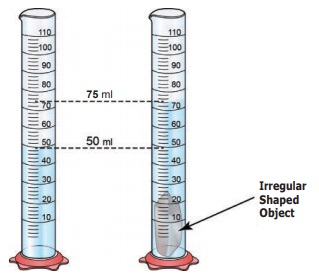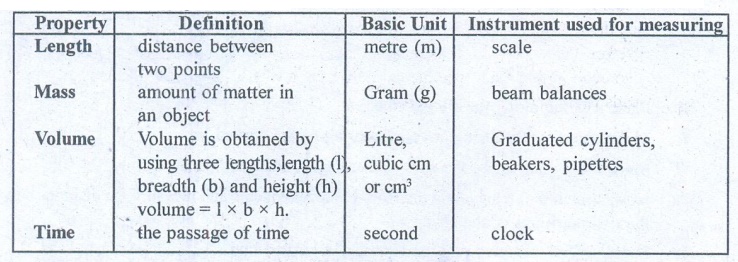Measurements | Term 1 Unit 1 | 6th Science - Questions Answers | 6th Science : Term 1 Unit 1 : Measurements
Chapter: 6th Science : Term 1 Unit 1 : Measurements
Questions Answers
Evaluation
I. Choose the correct answer
1. The girth
of a tree can be measured by
a. Metre scale
b. Metre rod
c. plastic ruler
d. measuring tape
Answer: (d) measuring tape
2. The
conversion of 7 m into cm gives
a. 70 cm
b. 7 cm
c. 700 cm
d. 7000 cm
3. Quantity
that can be measured is called
a. Physical quantity
b. Measurement
c. unit
d. motion
4. Choose
the correct one
a. km > mm > cm > m
b. km> mm > cm > km
c. km > m > cm > mm
d. km > cm > m > mm
5. While
measuring length using a ruler, the position of your eye should be
a. Left side of the point.
b. Vertically above the point where the
measurement is to be taken.
c. Right side of the point
d. Any where according to one’s convenience.
II. True or False
1. 126 kg is the correct way of expressing mass.
2. Length of one’s chest can be measured by using
metre scale.
3. Ten millimetres makes one centimetre.
4. A hand span is a reliable measure of length.
5. The SI system of units is accepted everywhere
in the world.
III. Fill up the blanks
1. SI Unit of length is symbolically represented as meter(m).
2. 500 gm = 1/2 kilogram
3. Distance between Delhi and Chennai can be
measured in
4. 1 m = 100 cm
5. 5 km = 5000 m.
IV. Analogy
1. Sugar: Beam balance; Lime juice?
2. Height of a person: cm; length of your
sharpened pencil lead?
3. Milk: volume; vegetables?
V. Match the following
Column A / Column B
1. Length of the fore arm - Metre
2. SI unit of length- Second
3. Nano- 103
4. SI Unit of time - 10–9
5. Kilo- Cubit
Column A - Column B
1. Length of the fore arm - Cubit
2. SI unit of length - Metre
3. Nano - 10-9
4. SI Unit of time - Second
5. Kilo - 103
VI. Complete the given table
Volume = litre : Kg = mass
Length of your little finger = hand span : Km : length.
VII. Arrange in increasing order of unit
1 Metre, 1 centimetre, 1 kilometre, and 1 millimetre.
Answer: 1 millimetre , 1 centimetre , 1 Metre , 1 kilometre.
VIII. Find the answer for the following questions within
the grid
1. 10-3
is one milli.
2. SI Unit of time second.
3. Cross view of
reading for a measurement leads to error.
4. Time is the one what a clock reads
5. Mass is the amount of substance
present in an object
6. Average can be taken to get the final
reading of the recordings of different of students for a single measurement.
7. Length is
a fundamental quantity
8. Odometer shows the distance covered by an
automobile
9. A tailor use tape to take measurements to stitch a
cloth
10. Liquids are
measured with this physical quantity

IX. Answer in a word or two.
1. What is the
full form of SI system?
• The full form of SI system
is International Standard
2. Name any one instrument used for measuring
mass.
• Instrument used for measuring mass is
electronic balance
3. Find the odd one out Kilogram, Millimetre,
Centimetre, Nanometre
Kilogram, Millimetre, Centimetre, Nanometre
• Kilogram
4. What is the SI Unit of mass?
• The SI Unit of mass is Kilogram.
5. What are the two parts present in a
measurement
• The two parts present in a measurement are a number and its unit.
X. Answer in a sentence or two.
1. Define
measurement.
• The comparison of unknown quantities
with some known quantities is known as measurement.
• Measurement of a quantity has two parts:
a number and its unit.
• E.g., 500 gm , 5 km
2. Define
mass.
• Mass is the measure of the amount of
matter in an object.
• Weight is the gravitational pull experienced
by the mass.
3. The distance
between two places is 43.65 km. Convert it into metre and cm.
• 1 km = 1000 m
• 43.65 km = 43.65 × 1000 = 43650 m
• 1 m = 100 cm ; 1 km = 100000 cm
• 43.65 km = 43.65 × 100000 = 4365000 cm
4. How
will you measure the volume of irregular objects?
• There is no mathematical formula to measure
the volume of irregular objects.
• By water displacement method we measure
the volume of irregular objects.
5. What
are the rules to be followed to make accurate measurement with scale?
• Correct position of the eye is important
for taking measurement.
• Your eye must be exactly in front of
vertically above the point where the measurement has to be taken.

• In the above representation, to avoid
parallax error, reading will be correct.
• From positions ‘A’ and ‘C’, the readings
will be different and erroneous.
• B is Correct position of the eye to take
measurement.
XI. Solve the following
1. The
distance between your school and your
house is 2250 m. Express this distance
in kilometre.
Solution: 1 km = 1000 m
• 2250 m = 2250 / 1000 = 2.25 km
2. While measuring
the length of a sharpened pencil, reading of the scale at one end is 2.0 cm and
at the other end is 12.1 cm. What is the length of the pencil?
Given: one end (starting) = 2.0 cm
other end (finishing) = 12.1 cm
To find: the length of the pencil = ?
Solution: The length of the pencil = finishing end - starting end
= 12.1 - 2.0 cm = 10.1 cm
The length of the pencil is 10.1cm.
XII. Write in detail
1. Explain
two methods those you can use to measure the length of a curved line.
Measuring the length of a curved line Using a string
• Draw a curved line AB on a piece of paper.

• Place a String along the curved line.
• Make sure that the string covers every
bit of the curved line.
• Mark the points where the curved line
begins and ends on the string.
• Now, stretch the string along the length
of a meter scale and measure the distance between the two markings of the string.
• Note it. This will give you the length
of a curved line.
2. Measuring the length of a curved line using a divider.
• Draw a curved line AB on a piece of paper
• Separate the legs of the divider by 0.5
cm or 1 cm using a ruler.

• Place it on the curved line starting
from one end. Mark the position of the other end.
• Move it along the line again and again
cutting the line into number, of segments of equal lengths. The remaining-parts
of the line can be measured using a scale.
• Count the number of segments
• Therefore, the length of the line = (number
of segments × length of each segment) + length of the left over part.
3. How
will you measure the volume of irregular objects?
• There is no mathematical formula to measure
the volume of irregular objects.
• But there are many ways to find volume
of irregular objects.
Water displacement method:
• Fill a graduated measuring cylinder with
water to certain level, say 50 ml.
• Tie the stone with a piece of fine thread.
Immerse the stone completely into water.
• As the stone is immersed, we can observe
that water level increases.
• The stone displaces the water to occupy
the space inside the measuring cylinder.
• It would be equal to the space taken
up by stone.
• So the amount of water displaced will
be the volume of the stone.
• This method is called as water displacement
method.

• Suppose initially the water level was
50 ml.
• After you immerse a stone the water level
rises to 75 ml.
• Volume of the water displaced is 75 ml
- 50 ml = 25ml
• 1 ml = 1 cubic cm
• 25ml = 25 cm.the volume of stone = 25cm3.
4. Fill
up the following chart.

Related Topics